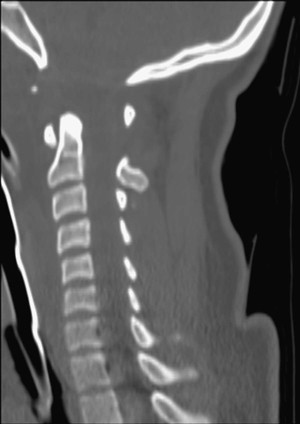16 ERIC SPICKLER A 20-year-old woman was hit by a car and presented comatose, in cardiac arrest. Sagittal reconstructed computed tomography (CT) of the cervical spine is notable for craniocervical dislocation (Fig. 16-1). Atlanto-occipital dislocation Although the patient’s vital signs were revived, she was declared brain dead. Atlanto-occipital dislocation is a common site of fatal injury in children sustaining significant upper cervical trauma. The fatality results from a hyperextension-distraction injury of the craniocervical junction leading to shearing of the cervicomedullary junction and respiratory arrest. While the mechanism is typically traumatic, it may be encountered in atraumatic cases such as Down syndrome or rheumatoid arthritis. The tectorial ligaments, which hold the condyles to the atlas, are torn. Atlanto-occipital dislocation is a radiographic diagnosis. Several measurements are described to establish the diagnosis. However, the condition is often grossly evident based on radiographs, the patient’s poor clinical condition, and the mechanism of injury. The Powers ratio takes the distance from the basion to the midvertical portion of the posterior laminar line of the atlas (BC), over the distance from the opisthion to the midvertical portion of the posterior surface of the anterior ring of the atlas (OA). If BC/OA is 1 or greater, the diagnosis is secured.
Atlanto-occipital Dislocation
Presentation
Radiologic Findings
Diagnosis
Treatment
Discussion

Atlanto-occipital Dislocation
Only gold members can continue reading. Log In or Register to continue

Full access? Get Clinical Tree








